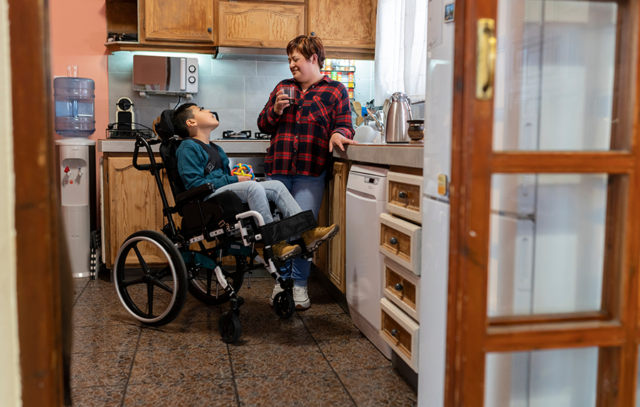
Parent PLUS Debt Relief: the Good and Bad
Some 3.6 million parents are paying off more than $100 billion in debt used to fund their children’s college education. For many parents, the federal Parent Loan for Undergraduate Students (PLUS) was the only way they could afford college, but many are now struggling to make the monthly payments.
In a Harris poll in July, nearly one in three said they regret the decision to borrow. If these parents need relief, they have two basic options: enter into the government’s repayment plan for PLUS loans or refinance their federal student loans through a private lender such as a bank. Both options have significant downsides.

Anna Helhoski, a student loan expert with the financial website, NerdWallet, explained the good and bad in the federal government’s income-contingent repayment program for parents overburdened by college debt.
Before we get into the details of this option, how big a problem is this?
We do know that parent PLUS borrowers are one of the fastest growing groups of people with student loans. With any student loan, you borrow to afford the degree so you can earn the money to repay the loan. But the conflict with parent PLUS loans is that you get the debt, but you don’t reap the higher earnings that come with a new degree. PLUS loans were originally meant to provide liquid funds for families with higher assets. But when it was opened up to more borrowers in 1992, it became a lot easier to take on more debt, and college costs were going up, so it became more of a necessity to access it.
Parents can easily rack up six-figure debt. The only requirement is that they don’t have adverse credit histories. PLUS loans are really easy to get and difficult to pay back. Repayment for parents – it’s probably the No. 1 question I get from anyone around repaying student loans.
Wouldn’t this be a particular concern for parents close to retirement age?
We know that is happening. Parents are putting off retirement because they can’t simply afford to retire because they have this debt looming.
Parents can get help from the federal government in the form of an income-contingent repayment plan (ICR). Generally, how does it work?
The standard repayment plan for new student loans is 10 years. But if parents are struggling to pay that debt, they have only one option: income-contingent payments over 25 years. The payments are set at 20 percent of their adjusted gross income on their tax filings, also known as discretionary income. And they can only get that if they first consolidate and then apply for the ICR program.
It’s not means-tested, so any parent PLUS borrower can qualify for ICR, but they are required to combine all of their PLUS loans first into a federal consolidation loan. If you don’t want to consolidate, you can’t access ICR.
What are the downsides of consolidation?
Your payments may be lower when you consolidate but you’re going to be paying the loans off over a longer period of time, which means you’ll pay more in interest over time. If you consolidate but don’t go into the ICR program, your term will be between 10 and 30 years – the larger the loan balance, the longer the term. The other downside of consolidation is that any outstanding interest on your existing loan balance will be added to the principal of your consolidation loan. You’ll be paying interest on your interest. If you consolidate and then enter the ICR repayment plan — the only option if you want to pin your payments to how much you can afford based on your income — your new term length will always be 25 years.
Given the downsides of ICR plans, what is the profile of the parents who could benefit?
It helps those with very high debt or people who are having trouble making their payments. The cheapest, fastest way to pay off your debt is to stay on the original 10-year repayment plan. But if you can’t afford it, ICR is a great way to stay on track so you don’t miss payments and eventually default. If you don’t have a job, for example, your payment is zero dollars. If you have six-figure debt and don’t have enough income to support repaying that debt, ICR will give you a lower payment, and the debt will be forgiven in 25 years. There’s a tax burden at the end of that but ICR may be the only way you can afford the debt.
Why is there a tax hit if any unpaid loan balance is forgiven after 25 years?
The IRS views debt forgiven as taxable income. As part of the American Rescue Plan passed by Congress in March 2021, all student loan forgiveness is tax free through 2025. It’s possible this will be extended but that’s not a guarantee. Because the payoff time is so long on the federal government’s four income-driven repayment plans, only about 30 people have received loan forgiveness under these plans so far. ICR is just one of those plans.
Is the interest rate on consolidated loans – whether you go into an ICR plan or not – higher than parent PLUS rates?
It depends on what your rates were each year you took out the original PLUS loans. The interest rate on consolidated loans is a weighted average of all the PLUS loans the parent has. The average is rounded up to the nearest 1/8 of 1 percent. It’s a fixed rate for the life of the consolidation loan, but there’s no cap on that interest rate.
When parents retire and their income goes down, do they pay less in the ICR plan?
They should. But it may be a very long time before they can pay off the debt. And they may pay a lot more interest while not attacking the principal, and then they’ll have a bigger tax bill at the end. That’s why so many parents are putting off retirement.
Does consolidation have any advantages?
Consolidation will simplify your repayment so you’re only going to have one loan and one monthly bill, and it allows you to enroll in ICR, which leads to loan forgiveness in 25 years.
Is the ICR program for parents different than the income-based repayment plans offered to recent graduates with student loans?
Yes. The parents’ payments are a much higher percent of their discretionary income. The most successful plan for college graduates is 10 percent of income. An ICR payment, once the parent consolidates, is always 20 percent of income.
How does the ICR program for parents compare with just refinancing the PLUS loans with a bank or other private lender?
The advantage of ICR is you have income-driven repayment, which is rarely offered as a repayment option by commercial lenders. Private lenders also don’t offer loan forgiveness. Refinancing with a private lender at a lower interest rate, if you qualify, might save you money, but you’d lose out on the federal government’s generous forbearance and forgiveness options.
Squared Away writer Kim Blanton invites you to follow us on Twitter @SquaredAwayBC. To stay current on our blog, please join our free email list. You’ll receive just one email each week – with links to the two new posts for that week – when you sign up here. This blog is supported by the Center for Retirement Research at Boston College.
Comments are closed.







When parents in ICR die before 25 years do their estates get the benefit of forgiveness?
Can I have an income contingent repayment plan for my car loan, and perhaps also for the credit card bill I ran up at Nobu? Silly me is not very financially sophisticated and mistakenly thought (oops delete that and say correctly thought) they didn’t need to be repaid.
Do you have any information on Biden’s plan to forgive parent plus loans that are under the public service loan forgiveness program?